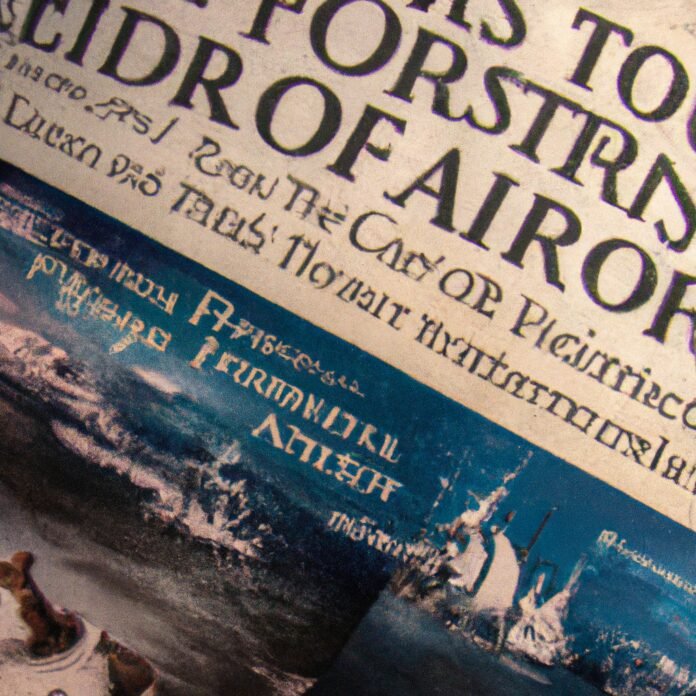For some, a journey to far and mysterious lands is a distant dream. But for the brave, the curious, and the wild at heart, a trip to the frozen frontier of the polar regions is a reality. Join us as we explore polar expeditions and Arctic adventures, a journey of discovery to the most captivating corners of the world.
1. Tales of Frozen Frontiers: Exploring the Last Remote Corners of the Earth
Auroras
Brushing aside the curtain of night, the Aurora Borealis ushers in a vision of grandeur and beauty rarely seen by the human eye. The Northern Lights blanket the sky in a glowing tapestry of greens and blues, extending to the horizon. It is a privilege to stand amongst them and marvel in their unparalleled splendour.
Frozen Forests
Buried amongst the snow and ice lies the silent beauty of the Arctic wilderness. Here, the trees stand tall and proud, their branches starkly silhouetted against a backdrop of white. Through the winter silence, you may hear the occasional swoosh of an owl’s wings in passing – a reminder of a treasured home.
Mountains of Ice
Far from the comfort of civilization, the spine of the earth will rise to meet you. These are some of the highest peaks in the world, sheathed in snow and surrounded by glaciers. To trek the glaciers of the North is to challenge the elements, carrying with you the very real danger of being trapped in the unforgiving icy terrain.
The Icebergs of the North
Vast and beautiful, the icebergs of the Northern waters move ever so slowly across the horizon, driven by the currents of the sea. They are a breathtaking sight, forming often-bizarre shapes – like something out of a fantasy novel. Watching these giants may fill you with a sense of awe and wonder – a reminder of the powerful forces of nature.
2. Battling Against the Elements: The Challenges of Polar Exploration
Polar exploration is one of the most difficult challenges that an explorer can face. The extreme cold, the freezing temperatures, the lack of oxygen, the treacherous paths, the days of darkness… all these things create a formidable environment.
One particular threat of the polar regions are the powerful winds. The winds can blow up to hurricane speeds and can be relentless for days on end. The wind can push explorers off their intended path, as well as create dangerous whiteouts where visibility is drastically reduced.
The icy terrain can also be treacherous. They can consist of solid field of snow or treacherous glaciers. Glaciers are notoriously difficult to traverse due to the ever-changing weather conditions and shifting boarders of the ice. Avalanches can also be a serious issue in mountainous regions.
Finally, the lack of daylight can be a major issue in polar exploration. With days or even weeks without sunlight, it can be difficult to determine directions, as well as cause mental fatigue. Furthermore, the lack of light makes it possible for dangerous crevasses to appear overnight which can take an explorer unaware.
Polar exploration can be a difficult and dangerous journey, but with proper equipment and knowledge, it is definitely achievable.
3. Making the Impossible Possible: Early Ventures into the Arctic
Exploring regions previously deemed impossible has been a quest of many courageous adventurers. Nowhere is this more evident than in Arctic exploration. Though arctic temperatures and dangerous weather conditions make parts of the Arctic an inhospitable place, daring early explorers saw it as a challenge worth undertaking.
The Danes and British: In 1585-1586, Danish navigator John Davis set sail from England for the first British-sponsored Arctic exploration. He and his fleet of five ships explored the area all the way up to Greenland, as well as the Davis Straight and the Baffin Bay. In the late 1700s, the British Admiralty launched several expeditions to the Arctic in order to chart its surrounds, fearing Russian and French advances in the north. These expeditions led by British naval officers, such as Sir John Ross and William Edward Parry, brought vital information about the Arctic regions back to commercial whalers who had venturing into those regions by then.
The Discovery of the Northwest Passage: Various efforts have been made in the past to discover the Northwest Passage, a shortcut from Europe to the north of the American coast is. Though John Davis is credited with discovering the first stretch of the passage, it was Sir John Franklin who declared he had traversed it in 1845 while captaining the HMS Erebus and Terror, though he eventually perished during the expedition. In 1906, Roald Amundsen became the first explorer to traverse the Northwest Passage boarding the Gjøa.
The exploits of these Arctic explorers paved the way for others to embark on adventurous treks across the region, pushing boundaries and making the impossible possible. From discovering unknown coastlines, to traversing the often icy waters and charting the passage- these exceptional early adventurers approached the Arctic with a sense of determination that led to remarkable accomplishments.
4. A Whole New World: Exploring the Wonders of Polar Life
From the frozen tundra of the Arctic to the unusual species living in the Antarctic, polar life is truly a wondrous world to explore. Here are some of the amazing things you’ll discover during your visit.
- Polar Bears – Polar bears are one of the most iconic creatures of the colder regions, and these magnificent beasts can be observed in their element in the Arctic and Antarctic, depending on the season.
- Aurora Borealis – Also known as the Northern Lights, this incredible natural display of light in the night sky is only visible in the winter in places with very dark skies, such as those found in the Arctic Circle.
- Seals and Whales – Heading out on a tour boat is a must-do for many people traveling to polar regions. You’ll see huge pods of seals, orcas, and other whales swimming in the pristine oceans of the far north.
- Icebergs – From a distance, these massive chunks of ice look majestic and unbreakable. But up close, they reveal an intricate array of colors and patterns, and their beauty is truly breathtaking.
The poles are also home to some of the most remote communities on the planet. Inuit and other indigenous peoples have been living in these regions for thousands of years, and their unique cultures are worth experiencing.
For those interested in science, the poles are hugely important. Glaciers and the permafrost contain evidence of the Earth’s climate history, which can help scientists understand and predict changes in the future. So, it’s not just a world of dramatic beauty, but of vital clues too.
5. Crafting a New Narrative: Modern Perspectives on Polar Exploration
Exploration of Earth’s polar regions has become increasingly important in recent years. Nations and organizations around the globe are working towards understanding the environment in order to help create solutions to global climate change.
But exploring today’s Arctic and Antarctic regions still faces the many dangers first encountered by the early polar explorers centuries ago. Visiting scientists, students, and other visitors now must be prepared for the punishing cold and other risks such as crevasses, storms, and wildlife.
Modern perspectives on polar exploration are centered in finding ways to explore the environment with minimal damage. New technologies allow for a more efficient and safe visit to these areas. Camera traps, drone reconnaissance, water-testing kits, and satellite imaging are all being used to assess the environment without human interference.
In addition, the idea of conservation rather than conquest of the pole is taking center stage. Scientists and government representatives of the affected nations are working together to discuss ways of preserving this unique natural environment.
- Drone reconnaissance can help conduct further inspection of potentially dangerous regions to better anticipate crevasses, ice conditions, and weather patterns.
- Camera traps are used to observe wildlife habits to protect and preserve the fragile ecosystems.
- Satellite imaging can be used to detect changes to ice and snow, giving organizations the ability to monitor the shifts in the environment.
If you’re ready for an Arctic adventure of a lifetime, take your first steps towards Frozen Frontiers. From unforgettable landscapes to unforgettable memories, this daredevil expedition is the perfect way to unlock the wonders of the north and explore all that the Polar regions have to offer. So have faith, take the plunge, and embark on your own Arctic adventure. Who knows how far you’ll go?

